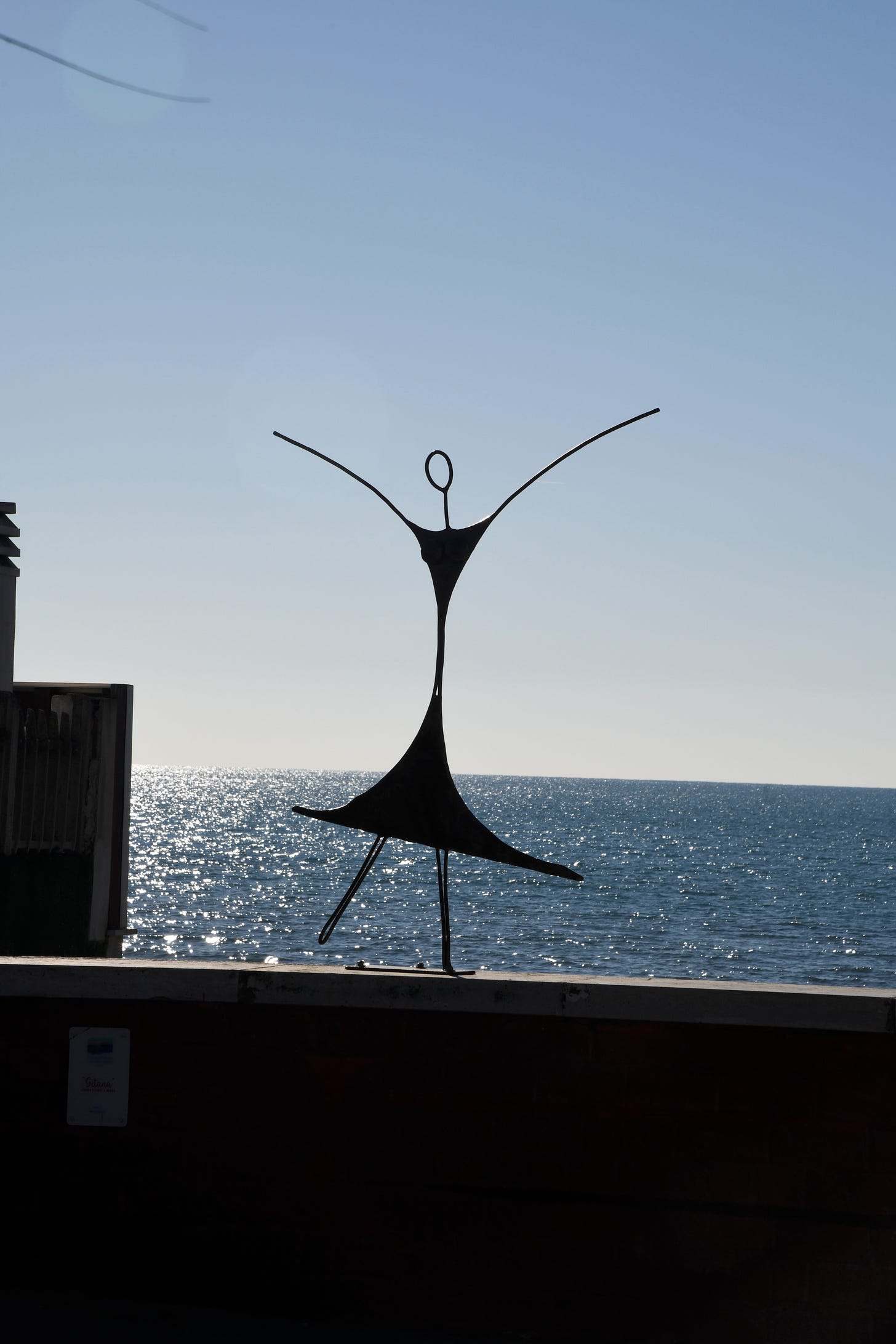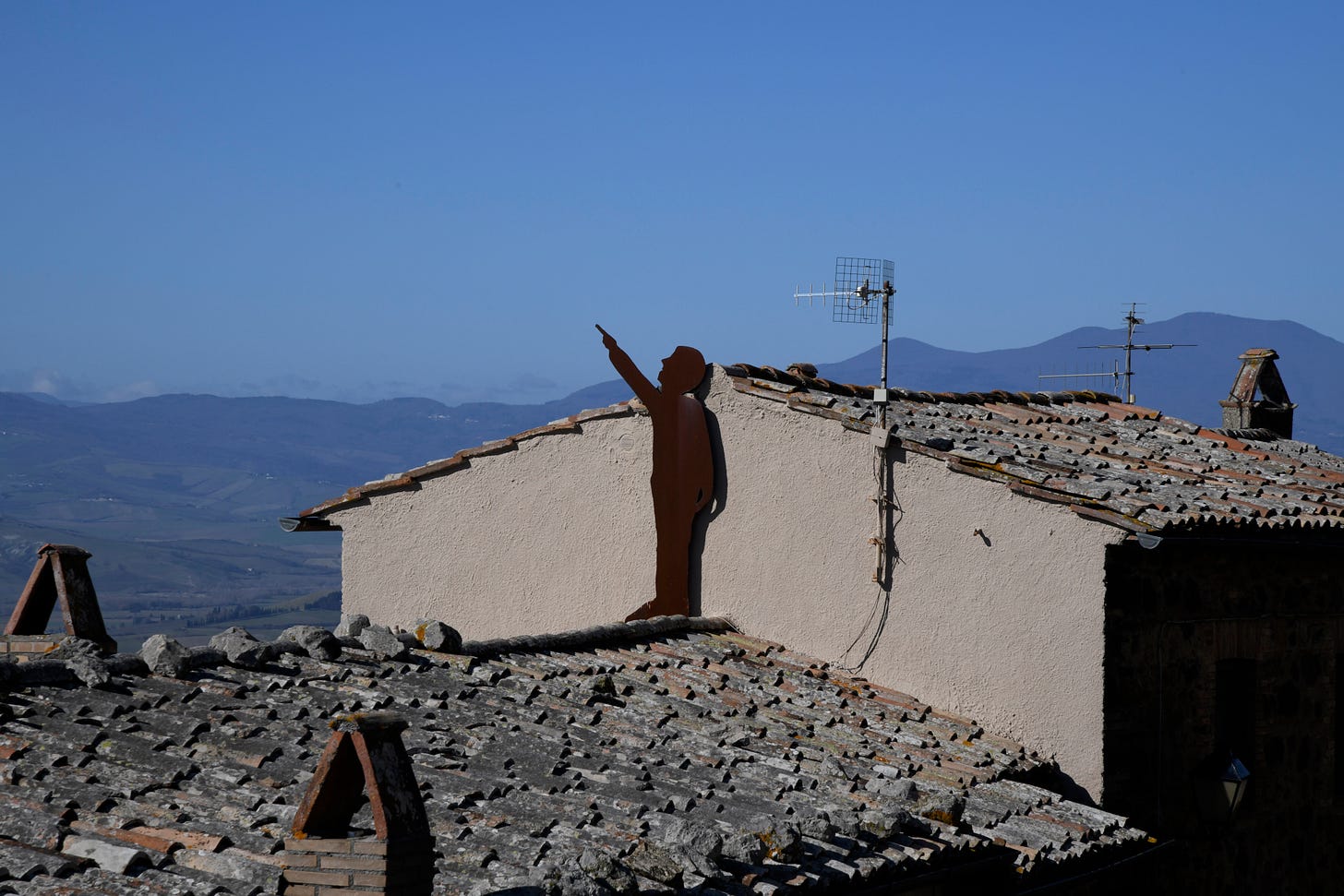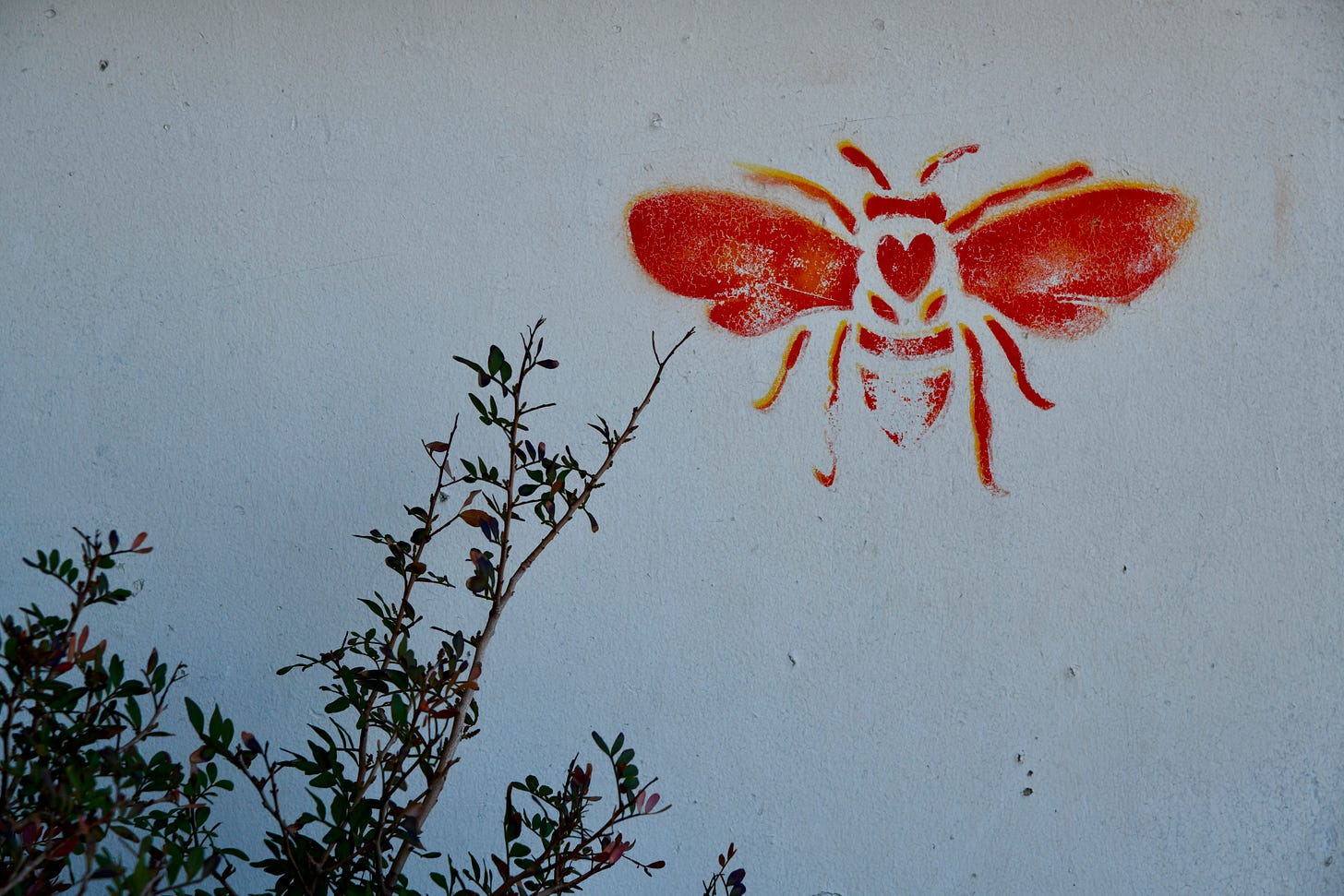Choosing Embodiment To Thrive
Embodiment is necessary - a vital place to discover how to feel alive.
We are not simply our thoughts. If all that made us are our thoughts, we would be walking heads. We have been given the gift of body. A body that senses, feels, emotes, acts, moves, and communicates. To have a vital and alive life, we need to learn how to access the body, to let the body communicate through us and as us. The body is asking us to awaken to it. When we question how to have a more fulfilling life, embodiment needs to be part of the equation.
When we are in relationship with other people, our energy is constantly changing. This is true not just when we are physically with other people but also when we are thinking of them, feeling emotions about them, and doing anything in relation to other people. Most of us are unaware of these constant changes. It takes more than just awareness of thought or emotion to be aware of the changes we undergo and what happens to our body in relation to others.
We need to be in our bodies to know what the body is doing, feeling, saying, and teaching. We need more than the mind. We need the body as a sensate organ and a medium for information.
Just like cultivating a relationship to our baseline with breath, we also need to get to know our baselines around embodiment. A daily awareness of how the body is inhabited without the stimulation of another person’s energy field has to be cultivated. We need to be interested in who we are without the input of others. This is the essence of self care - knowing self so that when something changes we have a baseline to seek.
With a baseline, it becomes easier to feel how the input of just one other person affects our embodiment. Relating is complicated. It involves layering. Each person we interact with and each situation we encounter also changes our embodiment. We may have a default embodiment that gets triggered by just being around any other person besides self or we may have different ways of embodying around others. Knowing how to interact with people with an interest in greater embodiment, more “I am” brings us into a life of fulfillment and value.
What is Embodiment?
Embodiment is the connection we have to our physical being as a whole. Parts of us embody easier than others. Many of us embody easily into thoughts as “I am.” Embodiment has roots that grow deeper.
Embodiment is a felt sense of body, “I am” , and heart that does not need to be fought for, defended over, or masked. Embodiment has flow, connection, and self awareness intertwined in its nature.
Embodiment understands shut down, disconnect, and disassociation as defense, not true self. There is a seeking of more that comes with the desire to embody. With embodiment, there is an understanding that the body itself has value. Awareness of how much embodiment is occurring and what is being expressed with embodiment connects “I am” to body as teacher.
Acceptance of Reality
Parts of our bodies are uncomfortable to be with. Obviously physically it is natural to resist pain, numbness, tension, disease, or any physical discomfort. Emotionally we resist certain emotions. It is rare that someone wants to face fear and terror with embodied curiosity. Also there is a natural resistance or damping down of any uncomfortable flavors of emotion - anger, grief, loneliness, resentment, suffering - as well as plateaus that shut off happiness, joy, grace, and fun.
Avoidance is part of being alive. Being curious about what we avoid is important to becoming embodied. An embodied person becomes more comfortable with all flavors of emotion as well as all range of emotion.
Part of living is feeling alive through the ups and downs that life is automatically going to flow into. Part of being alive is not getting attached to just one emotion or a few emotions. We can’t curate our lives to only feel happiness. That’s not living. Sadness exists all over the world too. We deserve to feel both and trust our bodies to feel everything. This puts us in a flow of life instead of sitting in one eddy of it demanding that life is this one eddy or maybe a few eddies but no other.
How often does the outside world or our own internal idealization tell us that the goal of life is to feel everything not just one thing? There is such a push to feel happiness, be in love, embrace success, be physically abundant. This puts us in a dilemma when we actually do not feel happy, loved, successful, or abundant. We disembody in an attempt to falsely create this supposed perfect reality. We push to make it real even when it isn’t. Then when true reality becomes too difficult to fight, we collapse. This endless cycle of fake, push, collapse, push, fake, try harder, push, collapse is not fulfilling. It’s demoralizing. We deserve better but we need to embody and embrace life in all its aspects to do it.
To accept the reality of life means knowing that life is going to have ups and downs, joy and suffering, achievements and failures. This is not true of just the black and white pinnacles of all experiences but literally every experience in between. Everything we feel is part of living.
The decision has to be made personally on how to actually live in reality, not fight it. This means understanding what is being avoided and figuring out why it is being avoided. This involves not getting ahead of the self or getting lost in what happened in the past.
Embodiment Requires Awareness
A regular mindfulness practice increases the ability to withstand sensation in the body. Mindfulness creates a relationship between sensation and the body. It provides flow and awareness. It gives us more awareness of embodiment. It is too easy to get lost in thought and emotion as body. Body is also sensation.
Embodiment is more than our capacity to think, feel, or act. Embodiment is a fluid connection to self from the top of the head to the tip of the toes. To cultivate an awareness of embodiment, some sort of regular check in has to happen so that we know when something is right, wrong, or neutral to our energetic system. We need to know that our “I am” and our flow is being affected in order to embody.
Embodiment Requires Release
Embodiment takes awareness but also requires removing energetic blocks. We all have places in the body that we habitually cut ourselves off from. The heart may be a place we have trouble exploring because of a deep pain of loss or abandonment. The belly may hold an overwhelming fear that makes us disassociate and check out. The pelvis can hold blocks from trauma or disempowerment that are felt as pain. Sometimes we can pretend to have an outer flow of embodiment but the inner body is on lockdown. The body is always flowing in and out of defenses and protective patterns whether we are alone or with others.
All aspects of the body talks uniquely to you. Accessing embodiment invites you to use discomfort, pain, emotions, numbness, or disconnect as an invitation to process these withheld aspects of self and bring them into connection. The connection goes two ways. We need to be in connection with our self but we also need others to fully embody.
The process of embodiment is not just a one time experience. By calling the self into embodiment and being able to withstand a deeper sense of embodiment with another person, we are forming a relationship to a life of transformation. The body speaks through defense and shut down. Embodiment requires attention, curiosity, and listening.
When we shift our embodiment in the moment to something new and unexperienced and then relate with another person in that embodiment, we are building a bridge that recognizes a lifetime of body as teacher, embodiment as information, and the need to utilize both to feel alive.
No matter how much meditation, therapy, embodied connection, or emotional release work we’ve done, our relationship to our own embodiment is a constant work in progress.
There are always going to be places that want more of our energy in our bodies, more of our own “I am,” more connection to our hearts. There is also always going to be a place in life where we want to share more of ourself, feel deeper connections, have the ability to maintain expressing “I am” as it grows and feels valued.
This is why having a living understanding of our baseline embodiment is so important. As we change, our baseline changes. Life changes our baseline. So do other people getting closer or further away. Being aware of all these changes challenges us and also give us a sense of choice in difficult relationships and life situations.
Using Embodiment to Become Unstuck
Choice means choosing again, not repeating the same choices over and over again. When it comes to embodiment, choice means breathing different, being openly more aware of self, and inviting physical shifts into our body with trust. Of course, these shifts may create an emotional response that is uncomfortable or unfamiliar. That’s the point! New thoughts may arise that are different than we are used to.
Patterns change and get challenged in situations when we choose to embody differently, approach oursembodiment with more awareness, and own the change we are asking for. I speak here of life as teacher of the unknown. The body has unknown in it and can be chosen as teacher in the same way breath can be chosen as teacher. We attempt to create a change in a pattern utilizing what life has to offer instead of fighting it.
Changing Our Current From “No” to “Yes”
When we are disassociated, collapsed, or uncaring about our own embodiment, we are being shown the “no” we carry towards both life and body. This is also true when we make choices in life over and over again without changing them. So often the choice represents a “no” that does not approach embodiment but rather aligns with disembodiment.
To choose to escape, quit, burn bridges, end relationships, or consciously create repeating patterns are ways of habitually saying “no” to life. This is not getting unstuck. Rather it is actively choosing disembodiment over curiosity and change. Calling ourselves out on the “no” and utilizing our ability to choose again means we have to face embodying differently than we currently feel capable of embodying. We embody with body as teacher and with the unknown as ally and friend.
It is inevitable that a choice to change embodiment interacts with the unknown. If we knew how to embody to avoid something negative happening to ourselves, we’d have done it already. Embodiment as a methodology to come unstuck embraces the unknown as a factor of inevitability. Utilizing embodiment and the unknown side by side means we will have a new emotion, find an impulse towards a different way of acting, or have a new thought come up as we embody “yes” instead of “no.”
Ultimately we can see the choice to become unstuck as saying “yes” in places we habitually or normally say “no.”
Everyone has a different way of being in a situation. Knowing your own unique way of saying “no” and challenging yourself to uncomfortably say “yes” creates a new experience of embodiment. When we are breathing in flow, actively tracking and aware of embodiment, we are showing life the “yes” we carry forward into it.
Making Use of Breath
In order to enter the body, we can use the portal of breath. Places where we disassociate, separate from ourself, or do not allow energy to flow are places we need deep charging breaths. Places that we tense, stagnate, and block are places where we need flow and stretch, the breath of movement. Places we wrap into entangled knots of stress and anxiety, need slow, deep calming breath. Bringing different forms of breath to body creates an energetic connection to a place that we may too easily ignore, accept, or avoid.
If we start to change our energy with breath, awareness, and inviting shifts in embodiment, we will have more of an understanding of what changes and what stays the same when we are with other people. We may, for example, notice that a person we think we like creates a disassociation in us or that we get tense around someone that we think we trust. If a practice is made in which awareness and breath already exists to create change, we are more equipped to face the undercurrent of triggers that are natural and ongoing in relationship. If we do not walk around aware of our embodiment and just perhaps notice the louder signals of our body, then we are not going to be able to work with triggers without the trigger getting intense and the processing of it also being intense.
Don’t Forget to Integrate
We all need down time to integrate and process. I am not a proponent of constant push without time to process. A good movie binge session or time away from other people may be another way of saying “yes.” This “yes” is towards integrating what does not seem embodied and is especially necessary if we are addicted to overdoing in life. Responding to fatigue does not have to be negative. It can just be responding to a need that is not expansive. The pause in the breath is necessary. Embodiment needs integration time.
Pulsing Embodiment
Imagine walking around as an energetic, breathing being who understands that shift and flow is possible through the internal awareness of self. Immediate knowledge of being “off” or not in a healthy self dynamic occurs when embodiment lacks flow. Different kinds of breathing to bring the self back into the body, seeking flow, and easing entanglements are packed away, ready for use in the ever present self care tool box. Embodiment is a form of being alive that changes who the self is in life and in relationships. It is a self healing that turns into dynamic relational healing. Embodiment seeks a way to move into being in relationship as body and self. Self awareness arises along with a sense of choice towards deeper emotional expression, more connected communication, and vitality. Life is about being alive, not embracing dying.
Body Appreciation
Of course we have to want to be in our bodies to create embodiment. Regular embodiment practices forge a relationship that eventually establishes a trusted toolbox ready for use during moments of disembodiment.
Our bodies need to be our friends, our companions, our deepest love.
Our bodies are this miracle of continuous motion. We may feel dense but everything in our body is moving, changing, functioning, communicating, and creating to be alive in the moment. Consider the ever present processing and processes of the body within the Daoist concept of the ten thousand things:
The Tao that can be told is not the eternal Tao;
The name that can be named is not the eternal name.
The nameless is the beginning of heaven and earth.
The named is the mother of ten thousand things.
TAO TE CHING, 1
Here is a physical reality where all the unknown and taken for granted meet in a miracle in which an alive human being has the ability to thrive. Why do we take this for granted so easily? Why do we not devote attention and love to this body that is literally more complex than our imaginations can handle all at once?
Whether we see the body as divine or a compilation of scientific processes and mysteries does not change the face that interest in being in the body is the reason we are alive.
Our aliveness comes from breathing and inhabiting the reality of who we are. The body is not trying to punish us. It is not evil. It is a container to hold our deepest spiritual self. The light we have inside us is meant to be expressed through our ability to embody and love our self.
Some sort of ordinary interest in this process has to be present for embodiment to be part of living.
Ordinary interest means not just expecting extraordinary miracles or fantasized experiences in order for the body to tempt you into being. Ordinary interest implies the fact that the every day relationship you have with your body is something you want to engage in and be in relationship with.
Embodied consciousness is more about being all of who you are and less about changing the root of who you are. So much of our body experience is fighting the self, resisting the self, attempting to change the self, or disassociating from the self. When we bring not just awareness but also breath to our bodies, we are telling it that we are interested in it. When we bring breath to a specific part of our body, we are inviting it to join us in life. We are saying “yes!”
Want more? Meditations, Journal Exercises, and an Audio Version of this post is available to paid subscribers. This is where the change happens. Body becoming. Mind relaxing.
Keep reading with a 7-day free trial
Subscribe to mindfullynessa to keep reading this post and get 7 days of free access to the full post archives.






